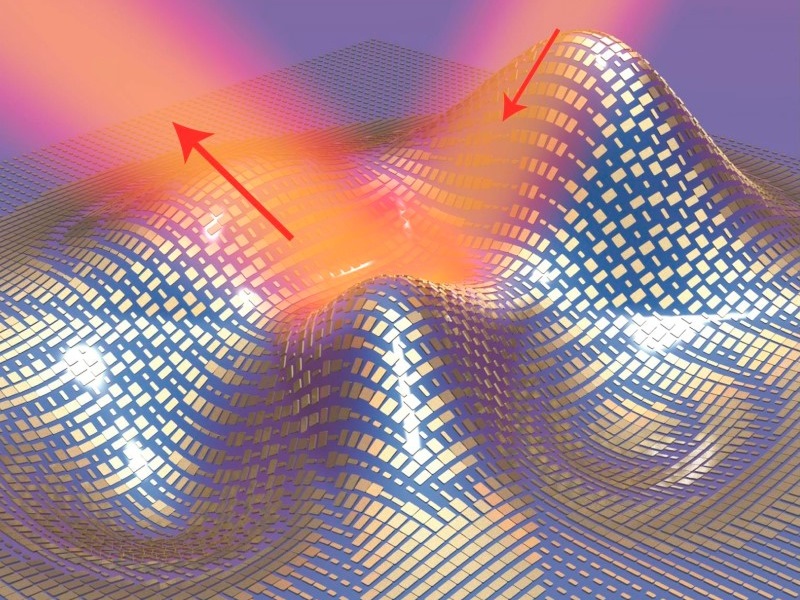- Home
- Science
- Science News
- Invisibility Cloak Nears Reality, Scientists Claim
Invisibility Cloak Nears Reality, Scientists Claim

Scientists said on Thursday they have successfully tested an ultra-thin invisibility cloak made of microscopic rectangular gold blocks that, like skin, conform to the shape of an object and can render it undetectable with visible light.
The researchers said while their experiments involved cloaking a minuscule object they believe the technology could be made to conceal larger objects, with military and other possible applications.
The cloak, 80 nanometres in thickness, was wrapped around a three-dimensional object shaped with bumps and dents. The cloak's surface rerouted light waves scattered from the object to make it invisible to optical detection.
It may take five to 10 years to make the technology practical to use, according to Xiang Zhang, director of the Materials Sciences Division of the US Department of Energy's Lawrence Berkeley National Laboratory and a professor at the University of California, Berkeley.
"We do not see fundamental roadblocks. But much more work needs to be done," said Zhang, whose research was published in the journal Science.
The technology involves so-called metamaterials, which possess properties not present in nature. Their surfaces bear features much smaller than the size of a wavelength of light. They redirect incoming light waves, shifting them away from the object being cloaked.
The cloaking "skin" boasts microscopic light-scattering antennae that make light bouncing off an object look as if it were reflected by a flat mirror, rendering the object invisible.
"The fact that we can make a curved surface appear flat also means that we can make it look like anything else. We also can make a flat surface appear curved," said Penn State University electrical engineering professor Xingjie Ni, the study's lead author.
The researchers said they overcame two drawbacks of previous experimental microscopic cloaks that were bulkier and harder to "scale up," or become usable for larger objects.
Ni said the technology eventually could be used for military applications like making large objects like vehicles or aircraft or even individual soldiers "invisible."
Ni also mentioned some unconventional applications.
How about a cloaking mask for the face? "All the pimples and wrinkles will no longer be visible," Ni said. How about fashion design? Ni suggested a cloak that "can be made to hide one's belly."
© Thomson Reuters 2015
Catch the latest from the Consumer Electronics Show on Gadgets 360, at our CES 2026 hub.
Related Stories
- Samsung Galaxy Unpacked 2025
- ChatGPT
- Redmi Note 14 Pro+
- iPhone 16
- Apple Vision Pro
- Oneplus 12
- OnePlus Nord CE 3 Lite 5G
- iPhone 13
- Xiaomi 14 Pro
- Oppo Find N3
- Tecno Spark Go (2023)
- Realme V30
- Best Phones Under 25000
- Samsung Galaxy S24 Series
- Cryptocurrency
- iQoo 12
- Samsung Galaxy S24 Ultra
- Giottus
- Samsung Galaxy Z Flip 5
- Apple 'Scary Fast'
- Housefull 5
- GoPro Hero 12 Black Review
- Invincible Season 2
- JioGlass
- HD Ready TV
- Laptop Under 50000
- Smartwatch Under 10000
- Latest Mobile Phones
- Compare Phones
- OPPO A6c
- Samsung Galaxy A07 5G
- Vivo Y500i
- OnePlus Turbo 6V
- OnePlus Turbo 6
- Itel Zeno 20 Max
- OPPO Reno 15 Pro Mini 5G
- Poco M8 Pro 5G
- Lenovo Yoga Slim 7x (2025)
- Lenovo Yoga Slim 7a
- Realme Pad 3
- OPPO Pad Air 5
- Garmin Quatix 8 Pro
- NoiseFit Pro 6R
- Haier H5E Series
- Acerpure Nitro Z Series 100-inch QLED TV
- Asus ROG Ally
- Nintendo Switch Lite
- Haier 1.6 Ton 5 Star Inverter Split AC (HSU19G-MZAID5BN-INV)
- Haier 1.6 Ton 5 Star Inverter Split AC (HSU19G-MZAIM5BN-INV)
-
 Kirkkan Is Streaming Now: Know All About This Malayalam Crime Thriller Film
Kirkkan Is Streaming Now: Know All About This Malayalam Crime Thriller Film
-
 Sony Teases New Audio Product as LinkBuds Clip Price and Features Leak
Sony Teases New Audio Product as LinkBuds Clip Price and Features Leak
-
 iPhone 17e Launch Timeline Leaked Again; Tipped to Feature Dynamic Island Instead of Notch
iPhone 17e Launch Timeline Leaked Again; Tipped to Feature Dynamic Island Instead of Notch
-
 Stop Guessing Keywords: Google Trends Adds Gemini to Suggest and Compare Topics Instantly
Stop Guessing Keywords: Google Trends Adds Gemini to Suggest and Compare Topics Instantly











